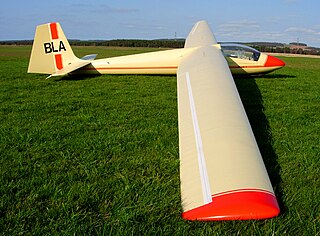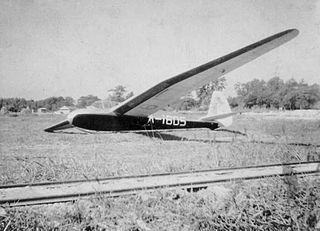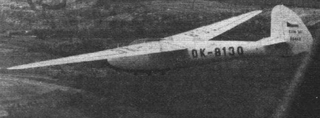
The ASK 13 is a two-seater glider that was built by German sailplane manufacturer Alexander Schleicher Gmbh & Co. It was and still is widely used for basic training of glider pilots.

The Schleicher K 8 is a single-seat glider designed by Rudolf Kaiser and built by the Alexander Schleicher company of Germany.

The Schleicher Ka 6 is a single-seat glider designed by Rudolf Kaiser, built by Alexander Schleicher GmbH & Co, Germany and is constructed of spruce and plywood with fabric covering. The design initially featured a conventional tailplane and elevator which was later replaced by an all-moving tailplane in the -Pe and Ka 6E variants. Variants built before the -CR and -BR used a main skid as the principal undercarriage, with later variants including the Ka 6E using a wheel as the main undercarriage with no nose skid. Other modifications for the Ka 6E include a more aerodynamic fuselage with glassfibre nose and wingroot fairings, longer canopy, and modified aluminium airbrakes.

The Slingsby Type 45 Swallow was designed as a club sailplane of reasonable performance and price. One of the most successful of Slingsby's gliders in sales terms, over 100 had been built when production was ended by a 1968 factory fire.

The Slingsby T.43 Skylark 3 was a single seat Open Class sailplane developed from the Skylark 2 with an extended wingspan. It won the 1960 World Gliding Championships.

The Slingsby T.50 Skylark 4 was a British single seat competition glider built by Slingsby Sailplanes in the early 1960s. It sold in numbers and had success at national, though not world level competition.
The Kirigamine Mita is a training glider, seating two in tandem, designed in Japan in the early 1960s. A modified version, first flown in 1966, was produced in modest numbers.

The Maeda 703 was one of the first indigenous Japanese gliders, a high performance single seat aircraft which first flew in 1940. Three were built, two with gull wing wings; one of these set a national endurance record in 1941.

The CVV-4 Pellicano was a single seat Italian glider designed for a competition to select an aircraft for the 1940 Olympic Games. The DFS Olympia Meise was preferred to it after the trials in Italy in 1939.
The VTC Delfin is a competition single seat Standard class glider designed and built in Yugoslavia in the 1960s. It had some success in national competitions and went into small scale production.
The CVV1 Pinguino was a single seat, high performance glider designed and built in Italy in the mid-1930s, the first of a series of gliders from the Milan Polytechnic. It did not go into production.
The UTG-1 Loudon was an intermediate glider designed and built at the University of Toronto in Canada during the late 1940s.
The Aeronautica Lombarda AL-3 was an Italian sailplane, designed and built in 1939 to take part in the Olympic sailplane competition. It did so but was not successful.
The Tedeschi E.T.186 was a simple, single seat training glider built in Italy and first flown in 1947. Only one was constructed.
The IIL IS-10 was a high-performance, single-seat glider, designed and built in Romania in the early 1960s. It was the first Romanian aircraft to use laminar flow airfoils.
The IIL IS-11 was an aerobatic, single seat glider, designed and built in Romania in 1959. It was built in small numbers.

The Schleicher Poppenhausen named after the town of Poppenhausen was a two-seat glider, available as a dual control advanced trainer, produced in Germany from 1928.
The Schleicher K 10 is a Standard class competition glider, designed by Rudolf Kaiser and built in Germany in 1963. Only a few were produced.
The Schneider ES-56 Nymph was a short span, Australian glider with a laminar flow wing, built in the 1950s. Only four were built.

The Zlín Šohaj series of club gliders began as a post World War II development of the DFS Olympia Meise. A large number were built in the 1940s and '50s.











